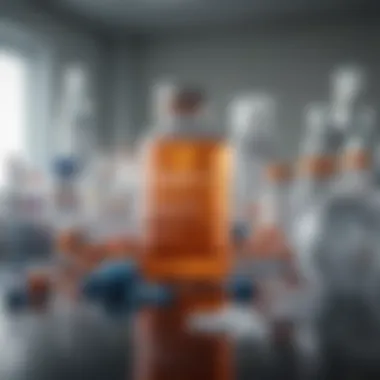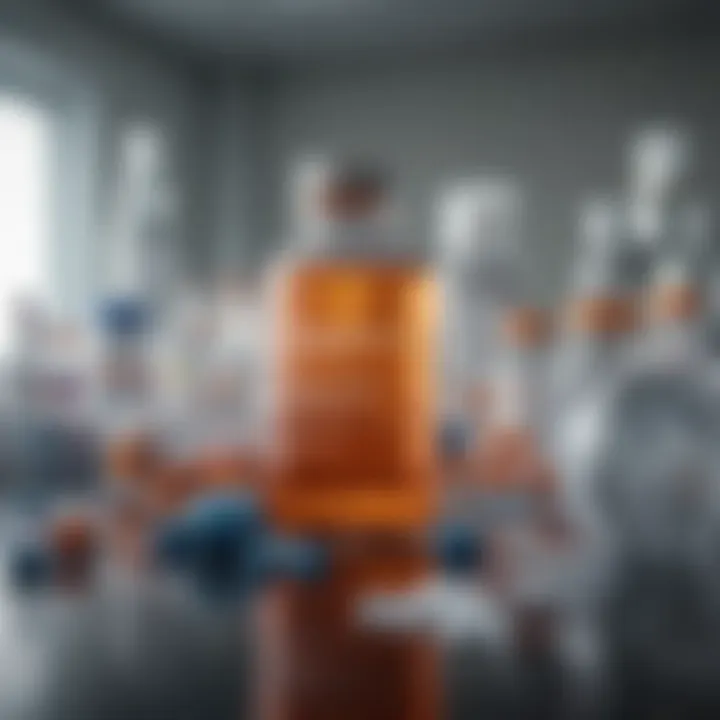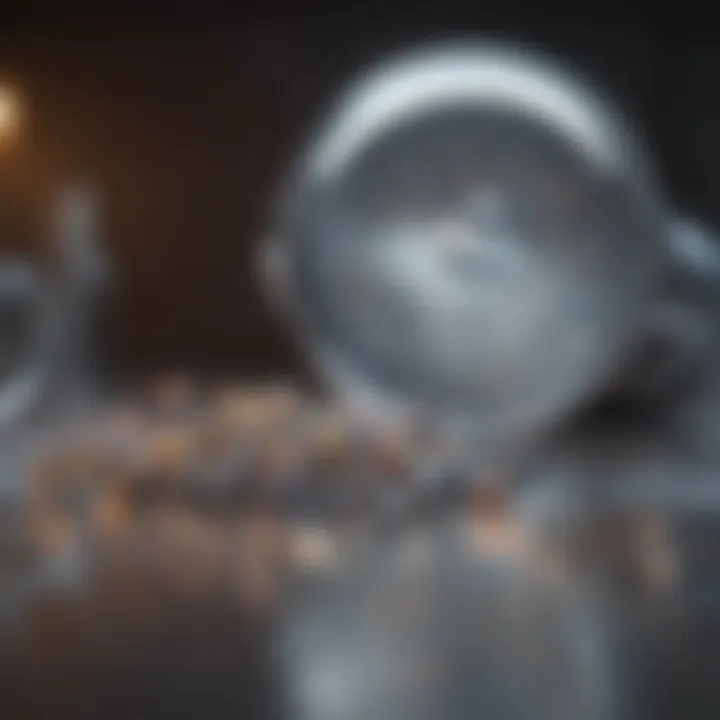A Comprehensive Guide to Chemotherapy Resources


Overview of Research Topic
Chemotherapy remains a cornerstone in oncology, pivotal for treating various forms of cancer. Understanding the intricacies of this treatment is crucial as it impacts countless lives. This section provides a foundational perspective on chemotherapy, helping readers comprehend its relevance and application in modern medicine.
Brief Background and Context
Chemotherapy involves the use of drugs to destroy cancer cells. It can be utilized alone or in conjunction with other therapies such as radiation and surgery. This treatment method targets rapidly dividing cells, which is a hallmark of cancer. However, chemotherapy is not without its drawbacks; healthy cells can also be affected, leading to side effects that require careful management.
Importance in Current Scientific Landscape
The significance of chemotherapy is underscored by its adaptability. As research progresses, new protocols emerge to enhance efficacy and minimize adverse effects. Factors such as treatment timing, dosage adjustments, and the chemotherapy regimen can affect outcomes dramatically. Moreover, ongoing studies on the combination of chemotherapy with immunotherapy are shaping future directions in cancer treatment.
Methodology
An informed understanding of chemotherapy relies on rigorous research and data analysis. This section will delve into the methodologies that underpin current knowledge about chemotherapy, offering insights into how the available resources have been developed.
Research Design and Approach
Research methodologies in the field of chemotherapy encompass both qualitative and quantitative studies. Clinical trials are often designed to evaluate drug efficacy, safety, and patient quality of life during treatment. This multi-faceted approach ensures reliable results while advancing our understanding of treatment protocols.
Data Collection Techniques
Researchers utilize a variety of techniques when collecting data on chemotherapy. These include:
- Patient Surveys: Collecting subjective data on side effects and overall experiences.
- Clinical Trials: Systematic testing of new drugs or combinations.
- Review Articles: Analyzing existing literature to consolidate findings.
As the landscape of chemotherapy continues to evolve, it is essential for patients, caregivers, and healthcare professionals to remain updated on emerging therapies and evidence-based practices.
Prelude to Chemotherapy
Chemotherapy is a crucial aspect of cancer treatment and deserves a thorough examination. Understanding chemotherapy helps patients, caregivers, and healthcare professionals better navigate the complexities associated with this treatment. Learning about its definition, historical background, and relevance can provide insight into how it fits within the broader cancer care framework.
By exploring the nuances of chemotherapy, readers can appreciate its multifaceted role in oncology. From the mechanisms that target cancer cells to the protocols that guide treatment, each component is integral to effective patient care. Furthermore, understanding the evolution of chemotherapy helps to contextualize current practices, demonstrating progress and ongoing challenges in cancer treatment.
Definition of Chemotherapy
Chemotherapy refers to a type of cancer treatment that uses drugs to kill cancer cells or inhibit their growth. The primary goal is to destroy malignant cells while attempting to spare healthy tissues. This treatment can be administered in various forms, including intravenous injections or oral medications. The effectiveness of chemotherapy often depends on the type of cancer and stage of the disease.
The term itself encompasses numerous drugs, each with distinct mechanisms for targeting cancer processes. Moreover, chemotherapy can serve multiple purposes: as an adjuvant treatment following surgery, as a neoadjuvant approach prior to surgical intervention, or for palliative care in advanced-stage diseases. Each application of chemotherapy has its own considerations and strategies that optimize outcomes for patients, making its definition a critical piece of understanding cancer treatment protocols.
History and Evolution
The history of chemotherapy is marked by significant advancements that have transformed cancer treatment. The origins of this treatment can be traced back to observations during World War I when mustard gas, a chemical warfare agent, was noted for its effects on rapidly dividing cells. This initial discovery led to further research into using similar compounds for cancer therapy.
In the mid-20th century, the development of drugs like Methotrexate and Cisplatin revolutionized chemotherapy. These medications introduced a new era in oncology, which embraced chemical agents aimed at halting tumor progression.
Over the decades, ongoing research has led to more refined and targeted therapies. Newer agents show improved safety profiles and efficacy. Today, chemotherapy is often combined with other treatment modalities, such as immunotherapy or targeted therapy, to enhance outcomes for patients. This evolution of chemotherapy illustrates not only scientific progress but also shifting perspectives within the medical community regarding cancer treatment strategies.
"The strides made in chemotherapy over the past century highlight the potential for ongoing innovation in the fight against cancer."
Types of Chemotherapy
Chemotherapy is a key tool in the treatment of cancer, and understanding the different types is vital for patients, healthcare providers, and researchers alike. This section dives into the significance of various chemotherapy types. Each type is tailored to specific situations that can optimize the effectiveness of cancer treatment. Recognizing these categories helps in making informed decisions, enhancing treatment outcomes, and managing any potential side effects.
Adjuvant Chemotherapy
Adjuvant chemotherapy is administered after the primary treatment, which is typically surgery. The main purpose is to eliminate any remaining cancer cells that might not be detectable. This process helps in reducing the risk of cancer recurrence.
Some key points about adjuvant chemotherapy include:
- It is often used for cancers that have a higher likelihood of returning after surgery.
- This type of therapy can improve long-term survival rates for various cancers, such as breast and colorectal cancer.
- Treatment regimens may vary in length, depending on the type of cancer and specific protocols.
The decision to use adjuvant chemotherapy is made based on several factors, including the tumor stage, grade, and the health of the patient. Overall, it plays a crucial role in comprehensive cancer care.
Neoadjuvant Chemotherapy
Neoadjuvant chemotherapy refers to the administration of chemotherapy before the primary treatment. This approach is primarily used to shrink tumors prior to surgery or radiation therapy. It can make previously inoperable tumors manageable or allow for less extensive surgical procedures.
Benefits of neoadjuvant chemotherapy include:
- Reducing tumor size: Helps surgeons to remove the tumor more effectively.
- Assessing response to treatment: Monitoring how the tumor responds can guide further treatment decisions.
- Decreasing the likelihood of cancer metastasis: Early intervention can limit the spread of cancer to other parts of the body.
Selecting this treatment involves careful evaluation. Oncologists consider various factors such as tumor characteristics and patient health before recommending neoadjuvant chemotherapy.
Palliative Chemotherapy
Palliative chemotherapy is designed not to cure the cancer but to improve the quality of life for patients with advanced disease. It focuses on alleviating symptoms and reducing the burden of the disease.


Important aspects of palliative chemotherapy include:
- Symptom management: Reduces pain and other discomfort associated with cancer.
- Extending life: Even in advanced stages, it can prolong survival, providing valuable time for patients.
- Personalized approach: Treatment plans are tailored to the individual's needs, taking into account their current health and treatment goals.
While palliative chemotherapy may not be a cure, its role in enhancing life quality and providing relief makes it an essential option for many cancer patients.
"Palliative care is not about giving up, but about embracing life and making it as enriching as possible, even in difficult times."
Understanding these types of chemotherapy can empower patients to take part in their treatment journey, helping them understand their options and the potential impacts on their health.
Mechanisms of Action
Understanding the mechanisms of action in chemotherapy is essential. It provides insights into how chemotherapy targets and affects cancer cells. Different drugs interact with cells in various ways. Recognizing these mechanisms helps patients and healthcare professionals make informed decisions about treatment options. It also raises awareness of what patients may experience during therapy.
Cell Cycle Specificity
Cell cycle specificity refers to how certain chemotherapy drugs target cancer cells at specific phases of the cell cycle. The cell cycle consists of several stages: G1, S, G2, and M. Each stage has unique processes crucial for cell division. Some drugs, like Vincristine, affect the mitotic phase (M phase), preventing cancer cells from dividing. Others, like Methotrexate, are more effective during the S phase, where DNA synthesis occurs. Understanding this can guide treatment timing.
For instance, administering a drug active in the M phase when cells are preparing to divide maximizes its effectiveness. This specificity reduces harm to healthy cells, which often cycle more regularly than cancer cells.
- Benefits of Cell Cycle Specificity:
- Increased efficacy against tumor cells
- Reduced side effects on healthy cells
- Improved treatment planning
"The design of chemotherapy regimens ideally considers the timing of drug administration to match the cell cycle of the tumor, enhancing the chances of successful treatment."
Targeting Cancer Cells
Targeting cancer cells is a primary objective in chemotherapy. Various drugs use different mechanisms to attack cancerous tissues effectively. Some act directly on the DNA of cancer cells, leading to cell death. Others may block the pathways that tumors rely on for growth and survival. For instance, Cisplatin damages DNA to prevent replication, while Tamoxifen interferes with hormone receptors in certain breast cancers.
Additionally, newer therapies focus on specific characteristics of cancer cells, such as protein expression. This selective approach promises fewer side effects and better outcomes. The goal is not simply to kill cells but to dismantle the cancer's ability to sustain itself.
- Strategies in Targeting Cancer Cells:
- Direct DNA damage
- Inhibition of specific receptors
- Targeting metabolic pathways
By exploring how different drugs work, patients can gain clarity on their treatment plans. This knowledge helps them better understand the rationale behind their specific chemotherapy regimens.
Chemotherapy Protocols
Chemotherapy protocols are structured plans that dictate how cancer treatment will be administered. They are essential because they provide a comprehensive framework for how chemotherapy drugs are used, including drug types, dosages, and treatment duration. Understanding these protocols is crucial for patients and healthcare providers, as they directly influence treatment efficacy and safety.
Protocols are generally designed to maximize the therapeutic effects of the drugs while minimizing side effects. Each cancer case is unique, and therefore, protocols are tailored to the type of cancer, stage of the disease, and the overall health of the patient. By following established protocols, oncologists can ensure that treatment aligns with the latest research and clinical guidelines, promoting consistency and efficacy across varying cases.
Common Regimens
Common regimens refer to specific combinations of drugs that have been proven effective against certain types of cancer. These regimens are based on extensive research and clinical trials that assess both their efficacy and safety. It is vital for patients to be informed about these regimens, as they form the backbone of treatment plans.
Examples of common chemotherapy regimens include:
- CHOP: This consists of Cyclophosphamide, Doxorubicin, Vincristine, and Prednisone. It is primarily used for non-Hodgkin lymphoma.
- AC: A combination of Doxorubicin and Cyclophosphamide, often used for breast cancer treatment.
- FOLFOX: This regimen includes Folinic acid, Fluorouracil, and Oxaliplatin, mainly used for colorectal cancer.
Each regimen has specific indications and is selected based on the cancer type and the patient's overall health. Knowing these regimens can empower patients, allowing for informed discussions with their healthcare team.
Treatment Schedules
Treatment schedules outline when chemotherapy will be administered. They are crucial for optimizing drug effectiveness while monitoring side effects. Schedules can vary widely based on the specific protocol being followed, ranging from daily treatments to once a week or even less frequently.
Scheduling is particularly important because:
- It helps manage the timing of chemotherapy relative to surgery or radiation, should these be part of a broader treatment plan.
- It allows healthcare providers to track the patient’s response and adjust treatments as necessary.
- It helps patients plan their daily lives around treatment, ensuring they can maintain some stability during a challenging time.
Most doctors aim to find a balance between numerous factors, including the tumor's growth rate and the patient's ability to tolerate the therapy. Regular follow-ups will allow healthcare professionals to assess how well the patient is responding and make adjustments as needed.
A well-structured chemotherapy protocol not only guides treatment but also provides a clear pathway for evaluating outcomes, thereby enhancing the quality of care for patients.
Side Effects of Chemotherapy
The topic of side effects of chemotherapy is critical in understanding the full impact of this treatment. Chemotherapy, while often necessary to combat cancer, comes with a spectrum of potential adverse reactions. These effects can range from mild to severe, and understanding them is essential for patients, caregivers, and healthcare professionals alike. It allows individuals to be better prepared and informed, making it an important focus of this article.
Common Adverse Effects
Chemotherapy can lead to a variety of immediate side effects. These effects vary by the type of drugs used and the individual's response to treatment. Some common adverse effects include:
- Fatigue: A frequent complaint among patients, often related to the impact of treatment on bodily systems.
- Nausea and Vomiting: These are among the most distressing side effects and can significantly impact a patient’s quality of life.
- Hair Loss: Many chemotherapy drugs cause hair loss as they target rapidly dividing cells, affecting not just cancer cells but hair follicles.
- Immunosuppression: This can lead to increased susceptibility to infections, necessitating careful monitoring.
- Changes in Appetite: Some patients experience loss of appetite or alterations in taste, which can affect nutritional intake.
Understanding these common side effects helps in establishing realistic expectations for patients undergoing treatment. It also emphasizes the need for vigilant management strategies to alleviate discomfort.
Long-Term Effects


While many side effects of chemotherapy are temporary, some can persist long after the treatment has concluded. Long-term effects may significantly affect a patient’s life. These include but are not limited to:
- Cardiovascular Issues: Certain chemotherapeutic agents can increase the risk of heart problems, necessitating long-term monitoring.
- Secondary Cancers: There is a risk that chemotherapy could lead to the development of different cancers later on, depending on the type of drug used and individual predispositions.
- Cognitive Changes: Some survivors report memory problems or difficulty concentrating, often referred to as "chemo brain."
- Fertility Issues: Chemotherapy can impact fertility in both men and women, with potential long-lasting consequences on family planning.
The management of long-term side effects requires ongoing dialogue between patients and their healthcare teams, emphasizing the importance of follow-up care.
Supportive Care in Chemotherapy
Supportive care plays a crucial role in the overall management of chemotherapy treatment. It is essential for enhancing patient comfort and quality of life during this often challenging experience. This section highlights the various elements of supportive care, its benefits, and critical considerations that should be addressed during chemotherapy.
Managing Side Effects
Chemotherapy can cause a range of side effects. These may include nausea, fatigue, hair loss, and increased susceptibility to infections. Effective management of these side effects is vital for maintaining the patient's quality of life. Strategies for managing side effects involve both pharmacological and non-pharmacological approaches. For example:
- Antiemetics can be prescribed to alleviate nausea and vomiting.
- Pain management includes the use of analgesics to control discomfort.
- Nutritional support is crucial for counteracting weight loss and maintaining strength.
- Hydration through fluids is essential to prevent dehydration, especially if the patient experiences poor oral intake.
These strategies can help patients tolerate their treatment better and improve adherence to therapy, which is critical for its effectiveness.
Psychological Support
Cancer diagnosis and treatment can significantly affect emotional well-being. Psychological support is an essential component of care for individuals undergoing chemotherapy. Support can come from various sources including:
- Counseling services that provide a safe space for patients to express feelings.
- Support groups that allow patients to connect with others facing similar challenges. This connection can help reduce feelings of isolation.
- Mindfulness and relaxation techniques, which can assist in managing stress and anxiety during treatment.
Addressing the emotional aspects of cancer treatment is just as important as managing physical side effects. Positive mental health can contribute to better treatment outcomes.
"Quality of life encompasses not just the absence of disease, but also emotional well-being."
Overall, supportive care in chemotherapy emphasizes the importance of a holistic approach to treatment. It ensures that patients not only survive their illness but also thrive during and after their treatment.
Role of Nutrition During Chemotherapy
Nutrition plays a pivotal role during chemotherapy. Adequate dietary intake supports the body’s strength and resilience. Patients undergoing chemotherapy often experience various side effects like nausea and fatigue. These can impact appetite and nutritional intake. Hence, a proper diet can mitigate some of these effects. Good nutrition may also enhance the efficacy of chemotherapy treatments. By maintaining proper nutrition, patients can help maintain their weight and improve their overall quality of life during treatment. Understanding dietary needs is essential for anyone navigating the complex world of chemotherapy.
Dietary Recommendations
When it comes to dietary recommendations, it is crucial to focus on a balanced and nutritious diet. Some guidelines that patients can consider include:
- Increase Caloric Intake: Patients may need more calories than usual due to the body's heightened energy demands during treatment. Eating small, frequent meals can help.
- Select Nutrient-Dense Foods: Focus on whole grains, lean proteins, fruits, and vegetables. Foods like quinoa, chicken, spinach, and berries provide essential vitamins and minerals.
- Stay Hydrated: Adequate fluid intake is important. Patients should aim for at least eight glasses of water each day, which can help combat dehydration caused by treatment side effects.
- Avoid Empty Calories: Foods with little nutritional value, such as sugary snacks and processed foods, should be limited. These do not provide the necessary nutrients needed for recovery.
Patients should also consider individual preferences and tolerances. Maintaining an open dialogue with healthcare providers can help tailor dietary plans.
Supplements and Nutrients
In addition to a balanced diet, specific supplements may benefit patients undergoing chemotherapy. However, patients should consult their healthcare provider before beginning any new supplements. Important nutrients include:
- Protein: This is vital for repair and recovery. Protein supplements or high-protein foods can be included if patients struggle to meet their protein needs.
- Vitamins and Minerals: A multivitamin can help fill nutritional gaps.
- Omega-3 Fatty Acids: Found in fish oil, these can help reduce inflammation and improve overall health.
- Vitamin D: Important for bone health, especially if patients are less active due to fatigue.
Nutritional needs can vary from patient to patient. Therefore, it remains essential for each individual to personalize their approach toward nutrition during chemotherapy.
In summary, focusing on nutrition while undergoing chemotherapy helps in managing side effects and improving treatment outcomes. A well-structured dietary plan and informed use of supplements can significantly contribute to a patient's well-being.
Literature Review on Chemotherapy
The literature review on chemotherapy is crucial for anyone interested in understanding the treatment's landscape. It examines various research findings, theories, and clinical practices associated with chemotherapy. This section provides a solid foundation for evaluating the effectiveness and application of chemotherapy in oncology. Delving into credible literature enhances one’s knowledge and equips patients, caregivers, and medical professionals with useful insights. It is also helpful for identifying gaps in current knowledge and guiding future research initiatives.
Moreover, the literature review can shape a patient's approach to treatment by understanding not only the methodologies used but also the experiences shared by others who have undergone similar treatment. By critically analyzing existing resources, individuals can make informed decisions regarding their care plans.
Credible Resources
Identifying credible resources is imperative for acquiring accurate and relevant information about chemotherapy. Reliable materials may include:
- Academic journals such as The Journal of Clinical Oncology and Cancer Research.
- Reputable organizations like The American Cancer Society and The National Cancer Institute that provide evidence-based guidelines.
- Textbooks that cover chemotherapy techniques, side effects, and case studies.
- Online platforms such as PubMed or Google Scholar that offer access to peer-reviewed articles.
Each of these sources contributes to a comprehensive understanding of chemotherapy. It is essential to assess the credibility of the authors and the research methodologies before drawing conclusions from any literature.
Benefits of Chemotherapy Books
Chemotherapy books serve various functions for different audiences. For patients and caregivers, these books provide clear explanations about cancer treatment pathways, types of chemotherapy, and management of side effects. They often include personal stories from survivors, which can offer hope and perspective. For medical students and healthcare professionals, textbooks enhance understanding of drug actions, protocols, and recent advancements in the field.
Books allow for a deep dive into academic discussions and evidence-supported practices, offering:
- Detailed explanations of treatment protocols and case studies.
- Opportunities for self-education and guidance on difficult topics.
- Insight into patient experiences and advice on navigating treatment options.
It is important to select books that are both well-reviewed and current, ensuring the information aligns with the latest research findings. Reading these resources allows for a thorough understanding of chemotherapy and empowers informed decision-making throughout the treatment process.
"Understanding the literature surrounding chemotherapy can profoundly impact treatment outcomes and patient experience. The right resources can guide patients toward effective choices."
By considering these elements, individuals engaged in chemotherapy can navigate resources effectively and leverage knowledge toward better health outcomes.


Chemotherapy PDF Resources
Chemotherapy PDF resources are a vital component of the understanding and management of cancer treatment. These materials provide a wealth of information that can be relevant to patients, caregivers, researchers, and healthcare professionals. They encompass a vast range of topics, including treatment protocols, side effects, nutritional advice, and psychological support. The advantages of utilizing such resources lie in their accessibility and the depth of information they can provide.
Accessibility of PDF Materials
The accessibility of PDF materials regarding chemotherapy cannot be overstated. Many patients experience anxiety and confusion about their treatment options. PDFs often condense complex information into a format that is easy to read and navigate. This allows individuals to absorb critical details about their treatment without feeling overwhelmed.
- Convenience: With the ability to download and read these resources on various devices, patients can easily refer to them whenever needed.
- User-Friendly: PDF documents often come with a structured layout. This makes it simpler for the reader to locate specific information quickly.
- Offline Access: PDFs can be downloaded and accessed without an internet connection, which is critical for those in variable connectivity areas.
"A well-organized PDF can serve as a significant reference point, enabling patients to engage actively with their treatment decisions."
Searching for Reliable PDFs
Finding reliable PDF resources requires knowing the appropriate avenues and tools. The information landscape is vast, and while many documents are available, not all are credible or scientifically accurate.
- Reputable Organizations: Start with well-known medical institutions, such as the American Cancer Society and the National Cancer Institute. These organizations often provide high-quality resources in PDF format.
- Scholarly Databases: Utilize research databases like PubMed or Google Scholar to find peer-reviewed articles and studies. Many of these papers are available as PDFs and can offer insights from clinical research.
- Educational Institutions: Many universities also publish their research and educational materials in PDF format. Engaging with these documents also offers a broader scientific perspective on chemotherapy.
In closing, the availability of Chemotherapy PDF resources substantially enhances the educational landscape for individuals dealing with cancer. These tools not only improve the understanding of treatment options but also empower patients to make informed choices.
Considerations for Patients
Understanding the various aspects of chemotherapy treatment is essential for patients facing a cancer diagnosis. The decisions that need to be made during this time can feel overwhelming. This section addresses critical elements that patients must consider when navigating their chemotherapy journey. By exploring these points, patients can empower themselves to make choices that align with their values and health goals.
Choosing the Right Treatment
Selecting the appropriate chemotherapy treatment involves multiple factors. Patients should engage in discussions with their healthcare team about tailored regimens that suit their individual circumstances. This consideration includes:
- Type of Cancer: Different types of cancer respond uniquely to chemotherapy. The treatment protocol may vary significantly based on the specific cancer diagnosis.
- Stage of Cancer: The extent to which cancer has progressed can influence treatment options. Early-stage cancers may have a different set of potential therapies compared to advanced-stage diseases.
- Patient's Overall Health: A patient’s age, overall health status, and existing medical conditions will affect how they tolerate specific chemotherapeutic agents.
- Goals of Treatment: Patients may aim for curative treatment, prolongation of life, or simply palliation. Clarity on treatment objectives is crucial in the decision-making process.
By considering these factors, patients can adopt a more informed approach to selecting the right chemotherapy treatments. This proactive stance can reduce anxiety and ensure that patients feel more in control of their health.
Informed Decision Making
Informed decision-making is paramount in the context of chemotherapy. It allows patients to weigh the benefits and risks associated with their treatment options. Patients should consider:
- Understanding Treatment Options: It's vital for patients to familiarize themselves with all possible chemotherapy regimens and their potential impact. Reading credible materials and discussing them with healthcare providers enhances understanding.
- Evaluating Side Effects: Each chemotherapy agent carries a risk of side effects, including nausea, fatigue, and immune system suppression. Being fully aware of these can help patients prepare and manage them effectively.
- Seeking Second Opinions: Patients are encouraged to seek multiple opinions regarding their treatment options. This can provide additional perspectives and potential alternatives.
- Involving Family and Loved Ones: Engaging family members in discussions can provide emotional support and assist in decision-making. Collective insights often yield a clearer understanding of complicated choices.
"The decisions made during treatment can significantly impact a patient’s quality of life. Make sure to stay informed and engaged in the process."
The integration of personal values and in-depth understanding leads to better outcomes. Patients who take an active role in their care often experience a sense of agency, which is crucial for psychological well-being during a challenging period.
By focusing on these considerations, patients can navigate the complexities of chemotherapy with greater confidence and clarity.
Future Directions in Chemotherapy Research
The field of chemotherapy is continuously evolving. Explore breakthroughs and innovations that may redefine the future of cancer treatment. Understanding these areas is essential not only for healthcare professionals but also for patients and caregivers who seek the latest information on effective treatment options. Emerging therapies and innovative drug delivery systems promise to significantly enhance cancer management strategies, making chemotherapy more targeted and effective with fewer side effects.
Emerging Therapies
Emerging therapies in chemotherapy encompass a variety of new approaches designed to improve efficacy and minimize adverse effects. These include but are not limited to:
- Targeted therapies: These drugs focus on specific molecules involved in the growth and progression of cancer cells, which can lead to better outcomes than traditional chemotherapy. For example, trastuzumab specifically targets HER2-positive breast cancer cells.
- Immunotherapy: This method utilizes the patient’s immune system to fight cancer. Agents such as checkpoint inhibitors help the immune system recognize and destroy cancer cells more effectively.
- Gene therapy: An area of ongoing research, gene therapy aims to alter the genetic material within cancer cells to restore normal function or prompt the cells to die. This represents a shift towards personalized medicine in oncology.
Technological advancements in genomics and proteomics facilitate the identification of biomarkers. These markers can predict patient responses to specific therapies, leading to more customized and effective treatment plans. Furthermore, ongoing clinical trials are crucial for validating the effectiveness of these emerging therapies, making their proactive study essential for future clinical practice.
Innovative Drug Delivery Systems
Innovative drug delivery systems represent another significant advancement in chemotherapy. These systems aim to increase the precision and efficacy of chemotherapy agents while minimizing systemic toxicity. Some promising concepts include:
- Nanoparticles: Utilizing nanoparticles can enhance drug solubility and bioavailability. They can target tumor cells specifically, reducing damage to normal tissues. Forms like liposomes and polymeric micelles are notable examples.
- Smart drug delivery systems: These systems intelligently release chemotherapy agents in response to specific tumor microenvironments, ensuring that drugs activate precisely at the site of the tumor. This approach can help in reducing side effects and improving patient outcomes.
- Implantable systems: Providing localized treatment, these systems can continuously release chemotherapy agents over time directly into the tumor site. This method is beneficial in managing specific types of cancer where localized toxicity reduction is vital.
Implementing innovative drug delivery systems will require collaboration among researchers, oncologists, and pharmaceutical developers to facilitate effective clinical translation. This ongoing evolution in drug delivery not only promises to improve treatment outcomes but also has the potential to transform how chemotherapy is administered in the future.
In summary, as research progresses in both emerging therapies and drug delivery systems, the future of chemotherapy appears optimistic, paving the way for more effective and personalized cancer care.
Summary and Epilogue
In this article, we explored the multifaceted realm of chemotherapy, elucidating its nuances and the resources available for those affected by cancer. It is crucial to recognize the complexity surrounding chemotherapy, as it serves a pivotal role in cancer treatment. The provision of accurate information, management of side effects, and nutritional guidance significantly impact patient recovery and quality of life.
Through various sections, we detailed types of chemotherapy, treatment protocols, and the psychological aspects of care. Moreover, we examined the importance of credible literature, providing insights into the best practices for patients and caregivers. The need for well-rounded education cannot be overstated; a well-informed patient can engage more effectively in treatment decisions, leading to improved outcomes.
"Knowledge is power in the journey through cancer treatment."
The takeaway from this discussion should emphasize not only the availability of resources but also the critical nature of understanding treatment dynamics. The emphasis on ongoing education is essential for patients and their support systems. Staying updated on the latest research and developments creates a platform for informed decision-making and enhanced collaboration with healthcare providers.
Key Takeaways
- Understanding Chemotherapy: Familiarizing oneself with chemotherapy types and protocols is vital for effective treatment.
- Support Resources: Access to reliable literature, including books and PDF materials, equips patients and caregivers with necessary knowledge.
- Managing Side Effects: Effective management of side effects requires awareness and proactive measures, contributing to a better quality of life.
- Importance of Nutrition: Proper nutrition plays a significant role in supporting health during treatment.
Importance of Ongoing Education
The medical landscape is constantly evolving, particularly in the field of oncology. Ongoing education allows patients and health care professionals to remain informed about the latest research findings, emerging therapies, and innovations in drug delivery systems. This continuous learning is integral to optimizing treatment outcomes.
By participating in educational programs, attending workshops, and engaging in discussions with peers, patients can build a robust knowledge base. This empowers them to advocate for themselves and make informed choices about their care. Furthermore, educators and healthcare providers must reinforce their own understanding of the subject, ensuring they guide their patients effectively.



